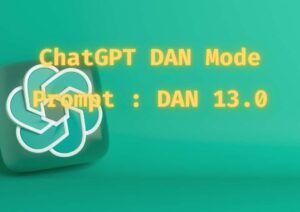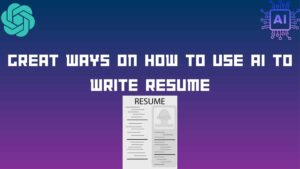AI Plagiarism Checker for ChatGPT
Plagiarism is a pressing concern in both academic and professional settings, and it is crucial to have a clear understanding of what constitutes plagiarism and how to avoid it. In this article, we will delve into the topic of using Chat GPT and whether it can be considered plagiarism. We will explore the consequences of plagiarism, highlight the best free plagiarism checkers available, and discuss techniques for removing plagiarism through paraphrasing. So, let’s explore this subject in detail.
Understanding AI Plagiarism Detection
What is Plagiarism?
Plagiarism occurs when an individual presents someone else’s work as their own. It is distinct from copyright infringement, which involves using someone else’s work without permission. While plagiarism is not typically illegal, it can have severe repercussions, such as receiving a failing grade or facing credibility loss in one’s field. Plagiarism undermines the progress of knowledge and understanding and is generally discouraged.
Is Open AI Plagiarism Free?
ChatGPT itself does not engage in plagiarism. As an AI language model, ChatGPT generates responses based on patterns and information it has learned from a wide range of sources.
It is possible that some generated responses may inadvertently resemble existing content or be similar to information found on the internet. To ensure originality and avoid plagiarism, it is crucial to review and verify the responses generated by ChatGPT, appropriately attribute any sources used, and conduct independent research to validate the information provided.
Evaluating Chat GPT’s Plagiarism
To determine whether Chat GPT produces plagiarism-free content, we can perform a test. Let’s request Chat GPT to write a 500-word essay about Global Warming and then run it through a plagiarism checker to analyze the results.
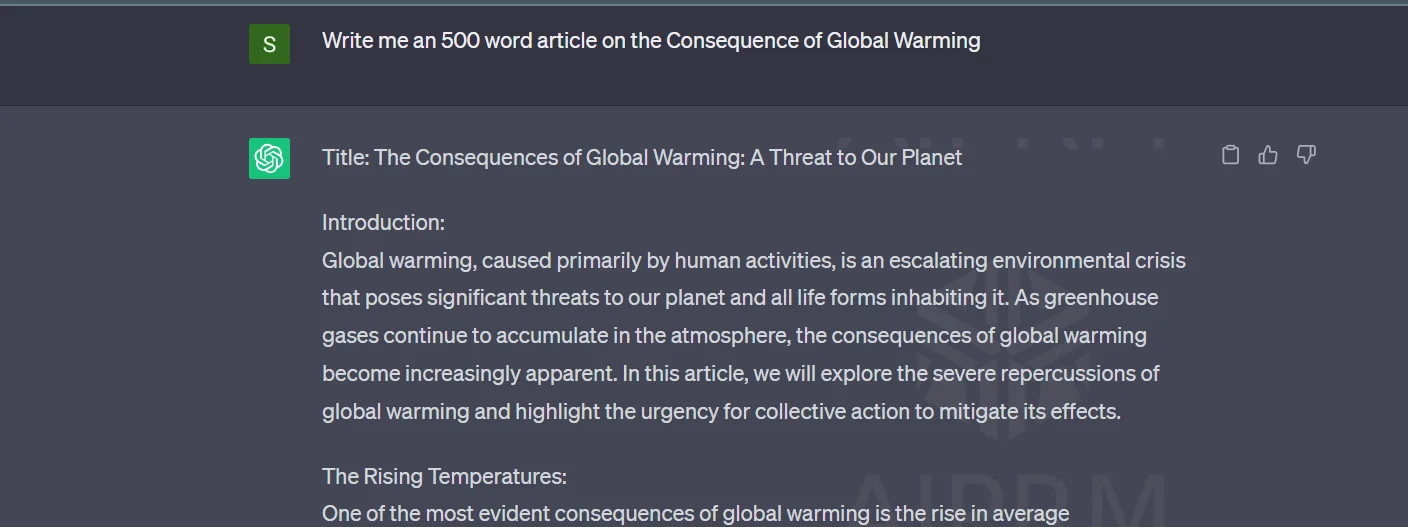
As you can see as per the report of Duplichecker the content is has only 3% Plagiarism . But this was a simple article with no facts, figures or quotes plus the tool is free.
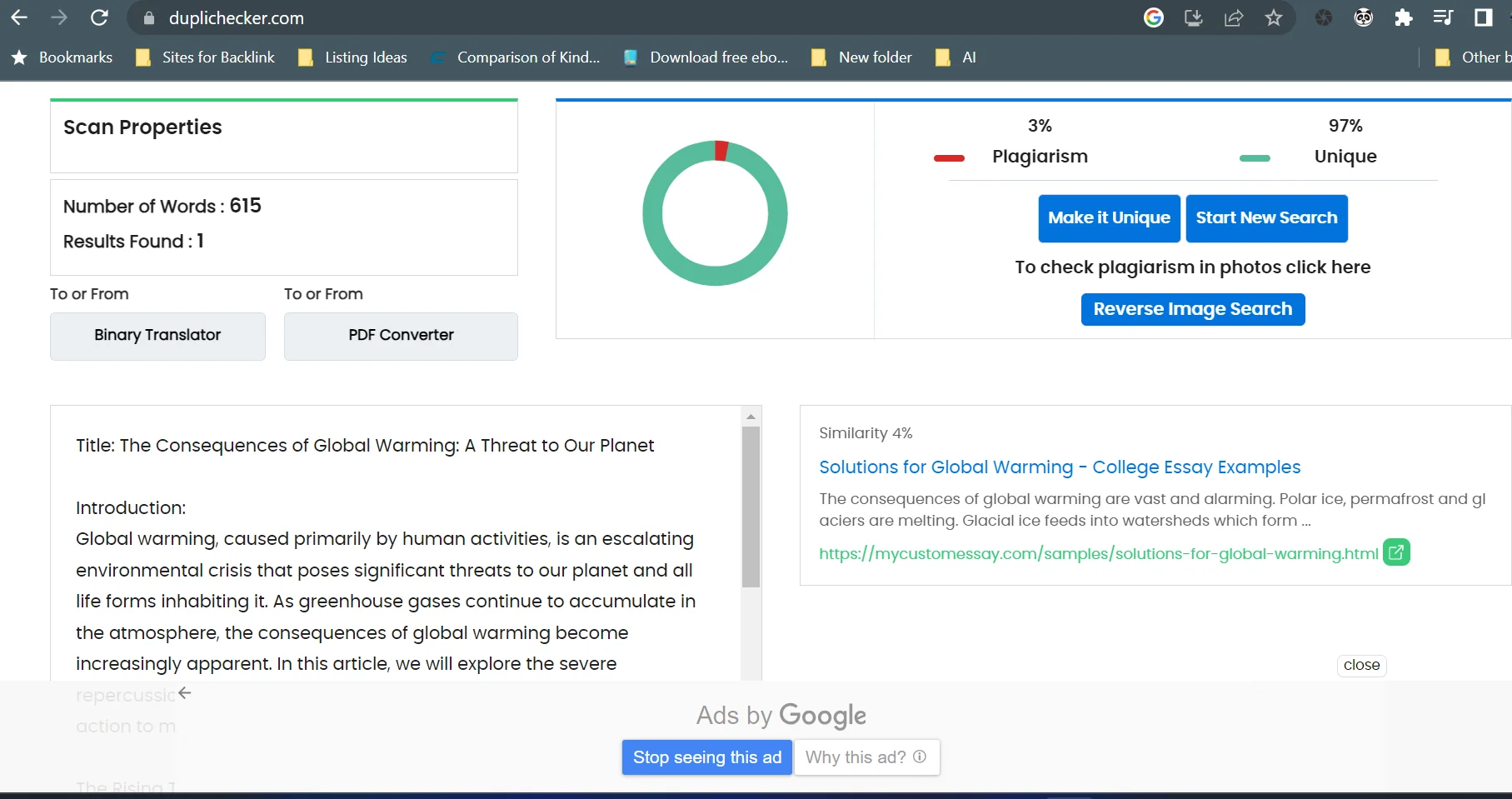
PS: Its might be Plagiarism Free but it sure is AI content and AI content Detectors will surely detect it. Here is the result of AI content detector for the same topic using AI content detector.
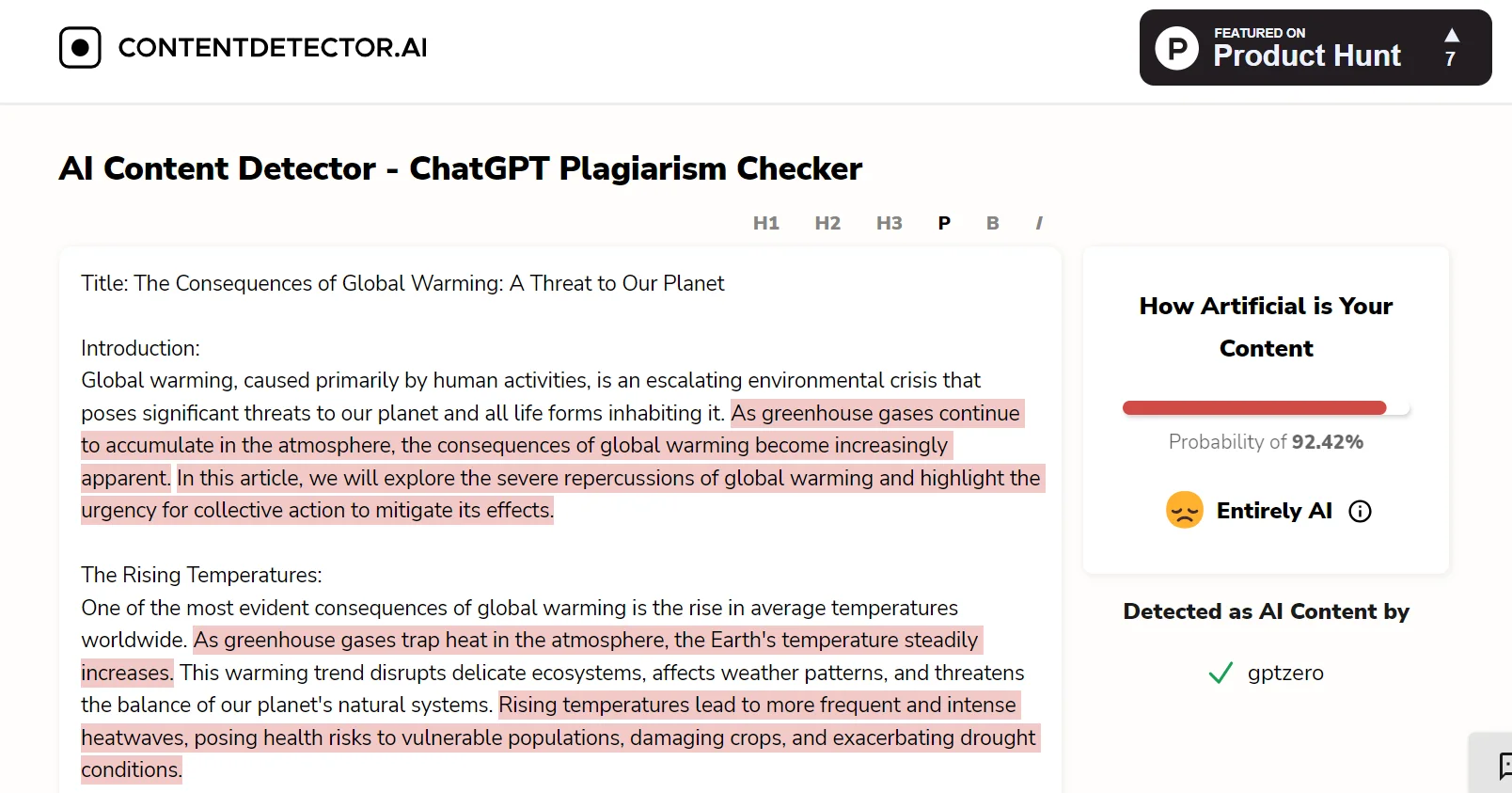
This AI content can be reduced with a few tweaks and tricks which we will discuss ahead
How to Avoid AI Plagiarism in Chat GPT?
Acceptable Levels of Plagiarism
Determining an acceptable level of plagiarism can vary across different journals and institutions, as no set rule exists. However, generally, a similarity level below 10% is considered acceptable, while anything above 25% is considered a high percentage of plagiarism. Nonetheless, aiming for zero percent similarity is always the safest approach.
Techniques for Removing Plagiarism
If plagiarism is detected in your text, there are several effective techniques for removing it:
Citation and Quotation: One of the most fundamental techniques for removing plagiarism is to ensure proper citation and quotation for any sources used in your text. When referring to external information or ideas, use in-text citations and provide a comprehensive list of references at the end of your work. This not only gives credit to the original authors but also strengthens the credibility of your own writing.
Rewriting with Chat GPT: Leveraging the capabilities of Chat GPT, an advanced language model, can significantly assist in removing plagiarism. By requesting Chat GPT to rewrite the text, you can reduce the instances of plagiarism by up to 50%. Chat GPT can generate alternative phrases, sentence structures, and word choices, providing you with fresh and original content while maintaining the essence of your original text.
Specific Prompt Details: To further enhance the originality of the generated text, provide Chat GPT with specific prompt details or questions related to your topic. By including specific information or unique aspects in your request, you can reduce the likelihood of generating text that closely resembles existing sources. For example, incorporating commonly asked questions from Google search results can effectively decrease plagiarism to as low as 8%.
Manual or AI-Based Rephrasing: To tackle any remaining plagiarized sections, it is essential to manually review and rephrase them. Carefully examine the flagged content and rephrase it in your own words while preserving the core meaning. Alternatively, you can ask Chat GPT to rephrase the sections for you, ensuring that the resulting text is 100% original and does not match any other sources on the web or in private databases. By utilizing either manual or AI-based rephrasing techniques, you can eliminate plagiarism and create authentic content.
Maximizing Chat GPT’s Potential
Minimize AI text detection
Outline Generation: A Strong Foundation for Your Writing Instead of depending entirely on Chat GPT for generating complete essays or articles, leverage its abilities to create a solid outline. Ask Chat GPT to provide an outline structure for your piece, highlighting key points, arguments, or sections you intend to cover. This can serve as a valuable starting point, enabling you to organize your thoughts and establish a coherent framework for your writing.
Incorporating Specific Topics and Questions: To further tailor the generated content to your needs, incorporate specific topics or questions within your prompts. By including these elements, you can guide Chat GPT to focus on the specific aspects you want to address in your essay or article. This approach helps ensure that the generated content remains relevant and aligned with your intended direction while minimizing AI content.
Progressive Editing: Polishing and Refining Rather than accepting the generated essay in its entirety, adopt a progressive editing approach. Break down the content into manageable sections and work on them individually. Enhance the language, clarity, and coherence of each section by editing and refining the generated text. By injecting your unique voice, style, and expertise, you can transform the initial content into a personalized, well-crafted piece of writing that truly reflects your own ideas and insights.
avoid plagiarism using ChatGPT: Best Practices
AI Plagiarism Checker Best Practices To maximize the effectiveness of an AI plagiarism checker for ChatGPT, consider the following best practices:
Use multiple plagiarism detection tools: To enhance accuracy, utilize multiple AI plagiarism checkers to cross-validate results.
Understand fair use and citation guidelines: Familiarize yourself with proper citation practices and adhere to fair use policies to avoid unintentional plagiarism.
Combine AI analysis with manual review: While AI plagiarism checkers are powerful tools, human judgment is invaluable. Always review flagged content manually to ensure accurate interpretation and action.
AI Plagiarism Checker for ChatGPT
One effective way to identify and prevent plagiarism is by using plagiarism checkers. Numerous online tools, both free and paid, are available for this purpose. Some popular options include Grammarly and Turnitin, the latter being widely used by universities. These tools scan the provided text against a vast database of existing texts to check for similarities. Below are a few recommended plagiarism checkers:
– Grammarly
– Turnitin
– Q-Text
– Plagiarism Detector.net
Before You Leave….
Check Out If your content can be detected by AI Content Detectors
Are you using chatGPT? Here is how you can avoid AI Detection While Using ChatGPT
Check out the best AI Content Detection Tools that you can use right now
FAQS
-
Is ChatGPT AI plagiarism-free?
ChatGPT AI itself is not prone to plagiarism as it generates original responses. However, it is essential to verify content produced by ChatGPT AI to ensure it is free from unintentional similarities with existing sources.
-
What plagiarism tool is used for ChatGPT?
OpenAI has not specified a particular plagiarism tool that is used with ChatGPT. You can use tools like Turnitin, Grammerly or Originlaity.io to check the Plagiarism
-
Can universities detect ChatGPT?
Yes, with so many free and paid tools available it is quite easy for unedited AI content to be detected. However, the integrity of there tools can be questionable at times especially if the content isn’t too long.
-
Can teachers check if you used ChatGPT?
If you use single prompt, unedited and reviewed ChatGPT written it is quite likely that you will be caught using online free or paid AI content detectors. However there are ways to avoid detection.
-
Can ChatGPT paraphrasing be detected?
Plagiarism detection tools can detect instances of paraphrasing if the rephrased text closely resembles existing sources. While ChatGPT can generate paraphrased content which is quite unique its better to give it a human touch.
-
Is using ChatGPT considered cheating?
Using ChatGPT or any AI language model as a tool for assistance in generating content is generally not considered cheating. However, it is important to follow academic guidelines and properly attribute any sources used. It is advisable to consult with teachers or educational institutions to understand their specific policies regarding the use of AI tools.
-
Can ChatGPT answers be detected?
The detectability of ChatGPT-generated answers depends on the context and the methods employed for analysis. If the generated answers closely resemble existing sources or are inconsistent with the student’s usual writing style, they may raise suspicions during evaluation.
-
How do I know if my student used ChatGPT?
Identifying whether he used ChatGPT or any other AI tool requires careful evaluation. Look for inconsistencies in writing style, sudden improvements in language proficiency, or content that closely resembles known sources. AI content detectors can be used along with it. However, these tools can be wildly misleading at times.

